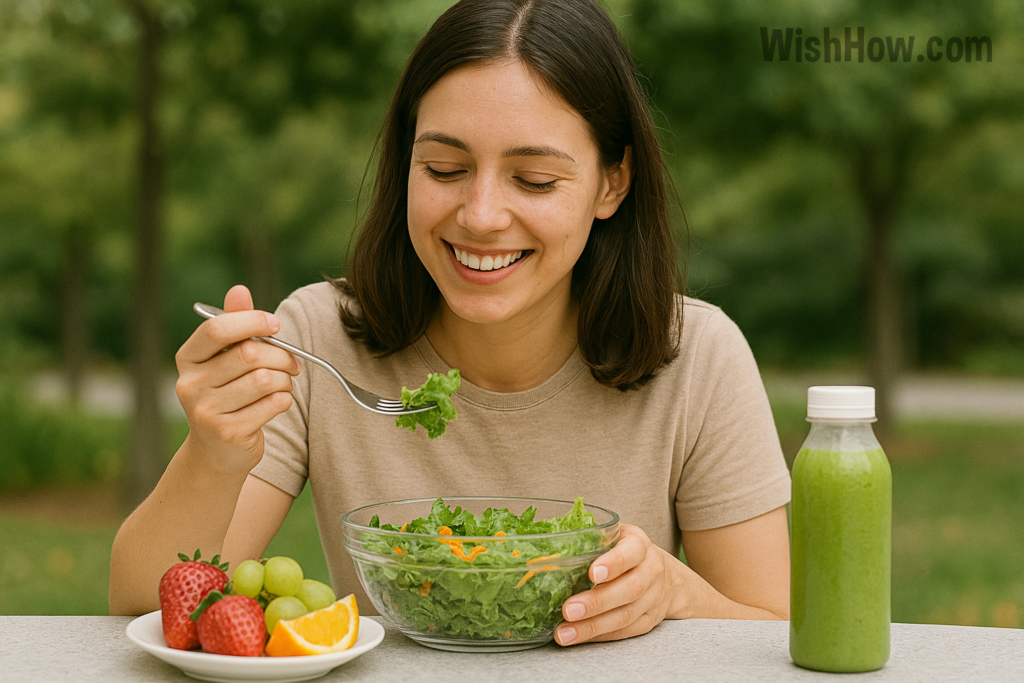Practicing gratitude can really change the game. It has a big impact, from improving your mental health to strengthening your relationships with others. When you live with gratitude, you start noticing the small wins—like the bus arriving on time, a stranger holding the door for you, or the sun shining through your window in the morning. These little moments add up to create a web of positivity that, over time, helps you focus more on the good.
Also Read: How Can I Change My Mindset to Attract Positivity?
How Do I Practice Gratitude?
Robert Emmons, a psychology professor and gratitude researcher at the University of California, Davis, explains that there are two main parts to practicing gratitude:
- Recognizing the good things we’ve received
- Acknowledging how others contribute to the goodness in our lives
We all know it’s important to thank the people who help us or quietly appreciate the good things we have. Studies have shown that practicing gratitude comes with many benefits, such as boosting your immune system, improving sleep, increasing feelings of optimism and joy, making you more generous, and helping you feel less lonely.
Want to enjoy these benefits? Start a gratitude practice today!

Practicing Daily Gratitude
As Jon Kabat-Zinn puts it, “The little things? The little moments? They aren’t little.” A simple “thank you” or holding the door for someone can completely change the vibe of your day.
One of the best ways to rewire your brain for more joy and less stress is by focusing on gratitude. Here are 10 easy ways to practice being more grateful:
- Keep a Gratitude Journal: Make it a daily habit to remind yourself of the good things in your life. Whether it’s the simple things, your personal strengths, or the people you care about, reflecting on them helps you build a lasting sense of gratitude.
- Remember the Hard Times: To appreciate your current situation, think back to tough times you’ve overcome. Seeing how far you’ve come can make you feel more thankful for what you have now.
- Ask Yourself Three Questions: Reflect on your relationships with loved ones using these questions: “What have I received from __?”, “What have I given to __?”, and “What difficulties have I caused?”
- Share Your Gratitude: Studies show that telling others you appreciate them strengthens your relationships. Next time someone does something nice for you, make sure to thank them!
- Come to Your Senses: Take a moment to appreciate the miracle of being human through your senses. Whether it’s the touch of a hug, the sound of music, or the taste of your favorite meal, these small moments can remind you of all the good in life.
- Use Visual Reminders: Since we often forget to be grateful, having visual cues around can help trigger those thoughts. Sometimes, the best reminders are the people around you.
- Make a Vow to Practice Gratitude: Research shows that when you commit to something, you’re more likely to follow through. Write a gratitude vow like “I will count my blessings every day” and place it somewhere you’ll see it often.
- Watch Your Language: Grateful people often use words like “gifts,” “blessings,” “fortunate,” and “abundance.” Shift your focus from what you’ve done to what others have done for you.
- Go Through the Motions: Simple acts like smiling, saying thank you, or writing thank-you notes can help you feel more grateful and spread that gratitude to others.
- Think Outside the Box: Look for new and creative ways to practice gratitude. Find situations where you can feel thankful and share your ideas with others!

Gratitude is a powerful tool for boosting happiness and well-being. Try these tips and see how they change your mindset!
Daily Gratitude Journaling
Journaling—whether in a diary, on scraps of paper, or just scribbling thoughts—has been around for centuries and is still a popular practice today. Anaïs Nin, a famous 20th-century writer and diarist, said that writing helps us “heighten our own awareness of life…to taste life twice, in the moment, and in retrospection.” She was onto something. Writing has a unique way of helping us see things differently, and keeping a journal is a great way to experience that shift.
Journaling is an easy and affordable hobby. It’s portable, and it helps us make sense of our thoughts, feelings, and experiences, letting us follow our personal story as it unfolds. It gives us space to slow down, breathe, and get real with ourselves—something often called “expressive writing,” especially in therapy. And journaling doesn’t just mean writing—it can also include sketches, doodles, or any other type of art. The beauty of this is you don’t have to worry about correcting mistakes or getting approval from others. Expressive journaling is all about expressing yourself, for yourself.
How to Start
There’s no wrong way to keep a gratitude journal, but here are a few ideas to get you going:
Write down up to five things you’re grateful for. It’s important to write them down—don’t just think about them. Your list can include small things (“The sandwich I had for lunch today”) or big things (“My sister had a healthy baby boy”). The goal is to remember something positive, then enjoy the good feelings that come with it.

9 Gratitude Writing Tips
As you write, keep these nine tips in mind:
- Be specific—The more specific you are, the more grateful you’ll feel. For example, “I’m grateful my co-workers brought me soup when I was sick on Tuesday” is more powerful than “I’m grateful for my co-workers.”
- Go deep, not wide—Focus on a specific person or experience and dive into the details. It’s better than just listing a bunch of things.
- Focus on people—Gratitude for people has a bigger impact than for things.
- Try subtraction—Think about what your life would be like without certain people or things. Appreciate the good things you’ve avoided, prevented, or turned into something positive.
- See good things as gifts—Treat the good things in your life as gifts. This helps you avoid taking them for granted and lets you really savor them.
- Savor surprises—Write about unexpected or surprising events. These usually spark stronger feelings of gratitude.
- Don’t repeat too much—It’s fine to write about the same people or things, but try to focus on different details each time.
- Write regularly—Pick a regular time to write, whether it’s every other day or once a week. Stick to it!
- Don’t overdo it—Writing 1–3 times a week is more beneficial than writing every day. We tend to get used to positive events, so it’s better to savor them when they happen.
Journaling can be a simple, yet powerful way to increase gratitude and boost your mood. Try these tips and see how your mindset shifts!
Also Read: What Are the Benefits of Gratitude Journaling?
Gratitude and the Brain
4 Ways to Train Your Brain to Practice More Gratitude
- Take time to notice what’s around you
Being mindful helps you focus on the present moment. If you’re already a grateful person, you’re probably more aware of the kind gestures from others. The more you tune into your surroundings, the more you’ll notice the good things around you that you can feel thankful for. Whether it’s the beauty of nature, kindness from others, or the opportunity to earn a living, being aware of your surroundings helps you appreciate all the good. Even small moments, like someone helping you in the kitchen or the color of the sky, can spark gratitude just by noticing them. - Practice gratitude for the little things
We often remember to be grateful for big events like graduations or weddings, but it’s easy to overlook the smaller moments we experience daily. Reminding yourself to be thankful for simple things, like a meal, can be powerful. Take a moment to enjoy the flavors of your food while it fills you up, and you’ll find gratitude in each bite. Another example is appreciating a good night’s sleep in the morning. By practicing mindfulness and gratitude in these everyday moments, you can feel more satisfied and at peace. - Share your gratitude with loved ones
It’s easy to take our loved ones for granted. The next time someone does something kind for you, take a moment to show your appreciation. A simple “thank you” or a hug can go a long way. By expressing your gratitude, you not only brighten their day but also strengthen your bond with them. - Spread gratitude on social media
Social media can often feel negative, but you can help turn it around by sharing your gratitude online. Post about something uplifting, like a happy moment from a recent event, a lesson you learned from a book, or a picture of a place that makes you feel grateful. By spreading positivity, you can inspire others and remind everyone of the many things we have to be thankful for.

Training our brains to practice gratitude more often is possible if we stay mindful of ourselves, each other, and the world around us. Let’s expand our circle of appreciation. What are some ways you remind yourself to be grateful?
Out of Your Mind
$29.66 (as of May 23, 2025 18:29 GMT -07:00 - More infoProduct prices and availability are accurate as of the date/time indicated and are subject to change. Any price and availability information displayed on [relevant Amazon Site(s), as applicable] at the time of purchase will apply to the purchase of this product.)3 Ways Gratitude Benefits Our Brains
- It can help relieve stress and pain
Gratitude activates parts of the brain linked to pleasure, socializing, and emotion regulation. These areas also help control stress, heart rate, and arousal levels, which can lead to less stress and pain. When we feel grateful and recognize others’ help, our bodies relax, and we experience the calming effects of gratitude. - It can improve health over time
Gratitude is also connected to the brain’s “mu opioid” networks, which are involved in social bonding and pain relief. These networks may have evolved from the need to care for each other. Because gratitude taps into these bonding and stress-relief networks, it could explain why feeling thankful improves health over time. - It can help those with depression
Gratitude may even change the brain in a positive way for those struggling with depression. A study by researchers at Indiana University found that practicing gratitude can alter brain function in depressed individuals. This suggests that gratitude doesn’t just improve mood—it might also help rewire the brain for better mental health.
The Science of Gratitude
Gratitude helps us appreciate everything that shapes our lives. It’s not just about feeling happy when things are going well—it’s about making an effort to notice all the goodness that surrounds us, even when life isn’t perfect.

In the last 20 years, research in social science has shown that gratitude has real benefits for nearly every area of our lives. It’s been linked to better well-being and physical health. The Greater Good Science Center at the University of California, Berkeley, which specializes in emotional well-being, even calls gratitude the “social glue” that strengthens relationships.
Robert Emmons, as mentioned earlier, explains that gratitude has two key parts. First, it’s about recognizing the goodness in our lives—the gifts and blessings we receive. The second part is acknowledging that this goodness comes from outside of us—from other people, or sometimes from a higher power, fate, or nature. In short, gratitude helps us realize that we wouldn’t be where we are without the support and kindness of others.
A Brain Built On Gratitude
Gratitude is more than just a fleeting good feeling. Research shows that practices like writing gratitude letters or keeping a gratitude journal can improve mental health and overall well-being. In fact, these habits can help you feel more satisfied with life and boost your self-esteem, according to studies.

The Science: Feel Happier
In one study with nearly 300 adults seeking counseling, one group wrote a gratitude letter every week for three weeks. This group reported feeling much better mentally, even 12 weeks later, compared to those who didn’t write letters. Another practice, called “Three Good Things,” involves writing down three positive things that happened each day and reflecting on why they happened. A study found that people who did this were significantly happier and less depressed, even six months after the study ended.
How It Works: Strengthen Positive Recall
So, how do these gratitude practices help improve our mental well-being?
People tend to focus more on their “headwinds” (the challenges they face) than their “tailwinds” (the good things they experience). By paying more attention to our tailwinds, research shows we can boost happiness, optimism, and positive emotions.
Nancy Davis Kho, author of The Thank-You Project: Cultivating Happiness One Letter of Gratitude at a Time, explains, “Strengthening your positive recall bias makes it easier to see the good things around you even when times are tough.” She set a goal to write 50 thank-you letters and found that the process helped her handle life’s challenges better.
At first, Nancy struggled to come up with 50 people to thank. But as she started writing, her mood lifted, and she found herself extending gratitude to even more people—beyond just family and friends. She encourages others to write gratitude letters to people who inspire them, whose work or vision brings joy and clarity to their own lives.
Why Practice: Build Resilience
Gratitude isn’t just about feeling happy or staying positive. It doesn’t mean ignoring or suppressing negative emotions. As Robert Emmons explains in The Gratitude Project: How the Science of Thankfulness Can Rewire Our Brains for Resilience, Optimism, and the Greater Good, “practicing gratitude magnifies positive feelings more than it reduces negative feelings.” Gratitude helps you see the bigger picture and become more resilient when facing tough times.
Nourish a Grateful Body
When we dig into the science of gratitude, we realize there’s more to it than just a simple feeling. Scientists study gratitude in a few different ways:
- Trait gratitude: This refers to whether someone has a naturally grateful personality.
- Gratitude as a mood: This tracks how gratitude can change from day to day.
- Gratitude as an emotion: This is the fleeting feeling of gratitude we might have after receiving a thank-you note or kind gesture.
- Gratitude as a practice: These are activities, like journaling or writing thank-you letters, designed to boost our mood or feelings of gratitude.
The Science: Boost Immunity and Heart Health
Recent research has shown that grateful people—those who naturally practice gratitude—tend to have fewer common health issues like headaches, digestive problems, colds, and sleep disturbances. Practicing gratitude can even help reduce these physical symptoms. For example, one study found that college students who wrote about what they were grateful for once a week for 10 weeks reported fewer health complaints like headaches, sore muscles, and shortness of breath compared to other groups.
How It Works: Calm the Nervous System
Gratitude has physical benefits too. Dr. Emiliana Simon-Thomas, Science Director at the Greater Good Science Center, explains that gratitude can help lower blood pressure and increase vagal tone, which is linked to a more relaxed nervous system. The parasympathetic nervous system helps the body “rest and digest,” slowing down the heart rate and promoting relaxation.
This calming effect could explain why gratitude helps relax the body. In a study with heart-failure patients, those who kept a gratitude journal for eight weeks showed better heart health and more signs of relaxation than those in a control group.

Why Practice: Make Healthier Choices
Gratitude can even encourage us to make healthier choices. Grateful people tend to focus more on activities like eating well. Research shows that expressing gratitude can help us make better food choices, such as eating more fruits and vegetables and less junk food. In one study, high school students who wrote weekly gratitude letters showed healthier eating habits over time compared to those who just listed their daily activities. Other studies have found that gratitude journaling can improve sleep and lower blood pressure, contributing to better overall health.
Also Read: How Does Gratitude Support Manifestation?
The Art of Happiness: A Handbook for Living
$9.91 (as of May 23, 2025 18:29 GMT -07:00 - More infoProduct prices and availability are accurate as of the date/time indicated and are subject to change. Any price and availability information displayed on [relevant Amazon Site(s), as applicable] at the time of purchase will apply to the purchase of this product.)Thankful to Those We Love
Gratitude doesn’t just benefit us individually—it can also help strengthen our relationships with friends, family, and even people in our larger communities. The find-remind-bind theory, created by psychologist Sara Algoe at the University of North Carolina, explains that gratitude helps people: find new relationships, remind us of the value of existing ones, and bind us to those we care about. As Sara wrote in her 2012 paper on the theory, “Gratitude starts inside one individual, and its effects spread to a relationship, and maybe even throughout a whole social network.”

The Science: Stronger Connections
“Social connection is key to well-being,” says Lisa Walsh. Gratitude isn’t just an emotion that makes us feel good—it also motivates us to improve ourselves and our relationships. A study from the PAW Lab at UC Riverside found that high school students who practiced gratitude felt both “elevated” (happy) and “indebted” after writing gratitude letters. They also felt more motivated to become better people.
The find-remind-bind theory suggests that when we express gratitude, we’re not only paying back kindness, but also strengthening the bond we share with others. Gratitude can make us want to spend more time with someone and encourage us to engage in positive behaviors that benefit those relationships.
How It Works: Better Communication
Gratitude can also improve romantic relationships by reminding us why our partners are important. When couples practice gratitude, one partner’s appreciation often leads the other to show their commitment in return. One study found that when someone received a thoughtful gesture from their partner, they felt more grateful and connected, which made both people feel closer and more satisfied with the relationship.
Gratitude isn’t just about writing letters—it can be expressed through conversations or social media, too. When we express gratitude, it can help us communicate better. Practicing gratitude boosts our positive views of our loved ones, which can make us feel more comfortable discussing disagreements. A study found that people who expressed gratitude toward a partner or close friend found it easier to voice their relationship concerns in the future.
Why Practice: It’s Better Together
“Gratitude has brought our family closer,” says Randi Joy, a chiropractor and life coach from Ottawa. She and her family have been practicing gratitude for about five years. “When we talk about what we’re grateful for, we feel more connected,” she says. Whether it’s on a gratitude walk or sharing “gratefuls” at the dinner table, Randi’s family takes every opportunity to practice together.
So, whether you’re looking to boost your mood, improve your health, or build stronger relationships, research shows that gratitude offers significant benefits. The takeaway? Cultivating gratitude helps us shift our perspective to see the goodness around us. With practice, we can learn to navigate life’s challenges with greater resilience.
So, now find your very own best ways to practice gratitude daily. We wish you well in this journey.








